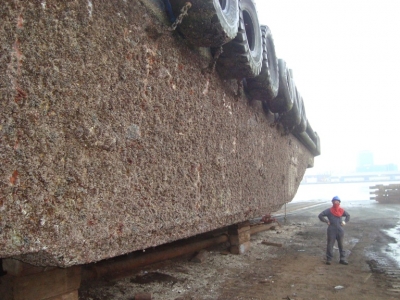
The shipping industry is among the biggest polluters in the world. It emits around 940 million tonnes of CO2 annually and is responsible for about 2.5% of global greenhouse gas emissions. Emissions, especially those of carbon dioxide, are directly proportional to fuel consumption. And shipping industry encounters an unusual problem in the form of marine biofouling which further contributes to its fuel consumption.
The marine biological fouling is the accumulation of undesirable marine organisms, including microbes plants, algae, and animals, on an immersed surface in seawater. This can be seawater cooling systems, platforms, buoys, underwater cables, oil installations, offshore structures and underwater acoustics instruments. In the case of ships, this accumulation usually happens on their hull. More than 4,000 marine species have been identified as biofouling organisms. Biofouling is divided into microfouling biofilm formation and bacterial adhesion – and macrofouling-attachment of larger organisms.
The surface-liquid interface such as the one between the ship’s hull and water favours an ideal environment for attachment and growth of micro organisms. Once attached, the microbes quickly establish a slimelike coating and multiply. Among macrofouling organisms, barnacles are arguably the most troublesome, in part because the hundreds of different species colonise a wide variety of marine surfaces, ranging from rocks and docks to whale fins. Barnacles are filter feeders. They benefit from a constant flow of water around them. They settle in an area with pronounced water movement or settle on a moving substrate such as a ship. They secrete a fast curing cement that is among the most powerful natural glues known. The glue is so strong that researchers are still figuring out ways to detach them from ships and other surfaces.
A cause for concern
- Accumulation of large colonies of barnacles for instance can increase the weight of the ships and cause them to drag and burn more fuel, leading to significant economic and environmental costs. These organisms may lead to decrease of speed by up to 10%, something that in turn may require even a 40% increase in fuel to counterbalance.
- Another major concern over biofouling is the spread of invasive aquatic species to new environments by ships. They may survive to establish a reproductive population in the host environment, becoming invasive, out-competing native species and multiplying into pest proportions. This problem has become more evident the last decades, as shipping traffic in the oceans has increased greatly.
Solution
The shipping industry employs a process called antifouling, which is a way to protect a ship’s hull with specifically designed materials, such as special paints, that prevent these organisms from piling up. But this is an expensive process and do not always work. Scientists are looking to employ robotics technology to clean the ship’s hull and prevent the build-up of fouling. The robotic cleaners can be used every time the vessel is anchored.
Picture Credit : Google




